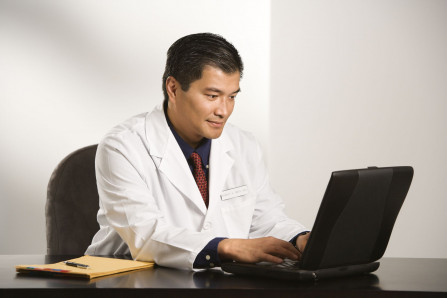Massage and trigger point therapy for shoulder pain, with self help options
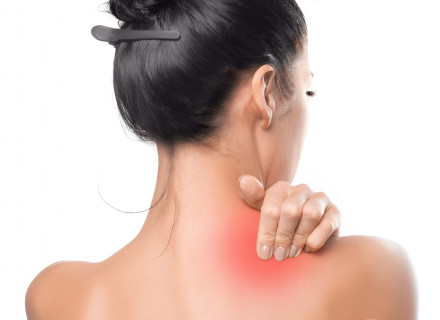
Muscular problems including trigger points have been shown to be a major cause of shoulder pain, and clinical trials show that massage and trigger point therapy give great relief (1–8). In this article we will share with you the muscles involved and the techniques found to be effective.
We include self treatment options
Trigger points can take a large number of treatments to properly eliminate, which can get very expensive if done professionally, so we will share with you effective, easy to do home therapies.
We show you all 17 muscles commonly involved
Research scientists identified that trigger points in 17 different muscles are commonly involved (1,9). For each of these we will show you:
- how to find them
- effective techniques
Other things you need to consider
While muscular problems and trigger points are extremely important causes of shoulder pain there are several other things you may need to do (or stop doing). We will look at these as well.
CONTENTS
Overview of the muscles involved
The basic massage techniques: including self massage
Specific techniques for each muscle
Other things you need to consider
Professionals
References
Overview of the muscles involved
The researchers have found that (myofascial) trigger points, or trigger points for short, in 17 different muscles were responsible for shoulder pain.
In this section:
- what are trigger points
- the 17 muscles that are involved
- how these trigger points cause shoulder pain.
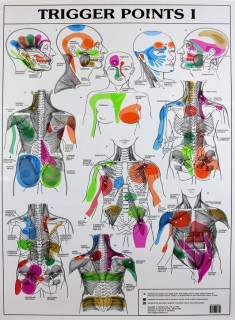
What are trigger points
Trigger points are those tender lumps in your muscles that refer pain when therapists press on them. We discuss these in depth in our article Your Complete Guide To (Myofascial) Trigger Points , but simply they are part of the muscle that has spasmed or cramped: tightening the muscle, restricting blood flow, and causing a build up of waste products.
Trigger points start as small lumps and gradually grow. As charts like these show they can eventually become bad enough to cause pain, but even when not hurting they will tighten the muscle and inhibit its function.
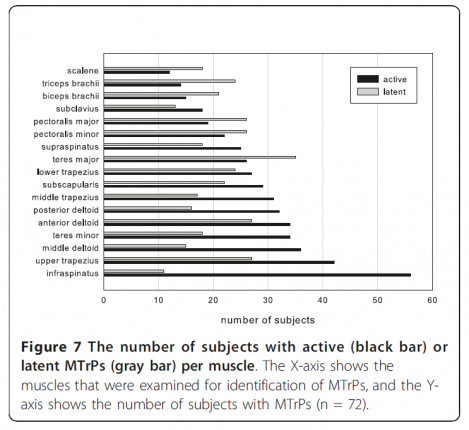
The 17 muscles that are involved
As this chart from a trial (1) shows researchers found that shoulder pain sufferers have trigger points causing pain in 17 different muscles. They examined 72 people. The chart shows the number of people with trigger in that muscle for each muscle.
Nearly 60 out of 72 had trigger points in their Infraspinatus muscle (back of the shoulder blade). On the other end of the scale we see that about 20 triceps and 20 scalene muscles had trigger points, but this is still about 30 %. Note that the percentages add up to well over 100%. This is because most shoulder pain sufferers had trigger points in many muscles.
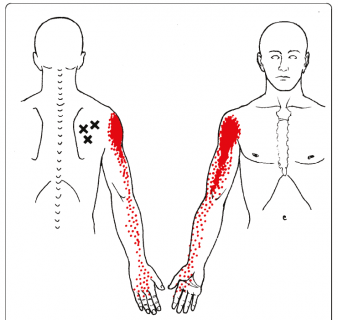
How these muscle cause pain.
Trigger points can cause shoulder pain by either:
- referring pain directly as shown in the example in this diagram, or
- cause the mechanics of the shoulder joint to become abnormal, as discussed in our article Why shoulder pain keeps coming back and what you can do about it .
The basic massage techniques: including self massage
In this section:
- An overview of treating trigger points
- Professional therapies
- Self massage and trigger point therapy
An overview of treating trigger points
Trigger points are a long term problem
If you have ever had a massage the therapist likely found parts of your muscles that were tight, felt ropey, and had tender lumps that you did not know were there. These are the trigger points, and it is important to understand that these are long term changes to your muscles.
Most course of treatment only give short term relief
If you have ever had experience with trigger point therapies before you will likely understand that courses of therapy such as needles, laser or pressure techniques may give relief, but the pain almost always comes back again. This is because long term changes such as ropiness and lumps need regular treatment over a longer period of time to revert back to normal. Typical courses of treatment just “quieten” it down a bit so they stop hurting, but the changes are still there.
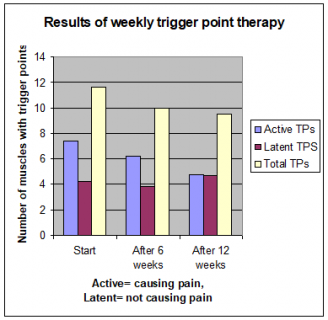
Proof that most courses of trigger point therapy do not eliminate the problem
This chart is from the report of where the top trigger point scientists gave extensive treatment using multiple therapies over 12 weeks. This is way in excess of most courses of professional therapies. It shows that while the patients felt much better most of the trigger points were still there.
The key to eliminating the problem
The key to reversing these changes and eliminating the problem is to continue the treatment for long after the pain goes away. Of course most people will not make a further 50-100 treatments once they feel better, so the only realistic option is using an effective, easy to do self therapy that can easily be continued.
Profession therapies
Professional therapists use a wide range of therapies and massage techniques, and usually do an excellent job. The drawback is, as discussed above, therapies need to be applied over a long period of time to reverse the long term changes to muscles. The professional therapists are most capable of doing this, but few patients would be willing to make the appointments and pay. Because of this most professional therapy tends to be only temporary pain relief.
Self massage and trigger point therapies
In this section we will show you the how to find trigger points, and how to do three basic self trigger point therapies. In the following section we will show you how to use these techniques on each of the 17 muscles.
In this section:
- How to find where to massage
- The basic techniques
How to find where to massage
This video discusses and demonstrates the general principles of finding the tight spots and trigger points in your muscles that will need treatment. Later in this guide we have diagrams and specific advice for each of the 17 muscles.
The basic techniques
Self therapy technique one: basic massage
This technique involves lubricating your skin, then while applying pressure move along your muscle like you are squeezing gunk out of an old sponge. The technique is demonstrated this video. It is very easy to do and fairly effective, but you can only do it yourself on muscles that you can easily reach.
Self therapy technique two: “Thai” self trigger point therapy
Professional therapists use various techniques based upon applying pressure direct to the trigger point. There are a lot of people advising to do this at home with balls and rollers. As I discuss in Do foam rollers work I do not recommend these.
- Clinical trial results of foam rolling have been mediocre
- In practice as a chiropractor I’ve seen way to many people hurt themselves using these and not a lot of benefits.
On the other hand there is a traditional Thai home therapy technique that appears to be very safe and was shown to be very effective in a trial treating upper back pain (11) . It uses a special tool with a long handle to apply moderate pressure to relaxed muscles. Each day each trigger point was given five applications of this moderate pressure for five seconds each. The big differences between this technique and foam roller/ balls are:
- you are not getting into difficult positions and the muscles you are treating can be relaxed,
- it is much easier to control the pressure, and
- rather than more painful and prolonged pressure the Thai technique uses multiple short duration applications of moderate pressure.
The trial of this therapy used a tool called a wilai stick (pictured), but there are many similar tools available.
Self therapy three: home trigger point therapy using vibration massage (our recommendation)
Vibration massage is widely used by professionals to treat trigger points. It is done by simply placing the vibration massager over the trigger point allowing the vibrations to penetrate and have their effect. Because it does not require penetrating pressure it is relatively safe, and because no special skills are required it is far easier to self apply.
In this section:
- How vibration massage works
- How to use vibration massage
- How to choose the appropriate massager
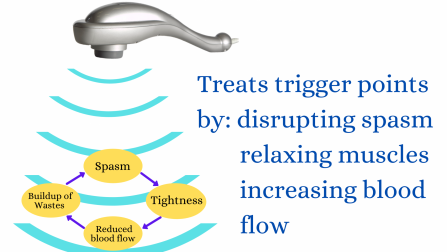
How vibration vibration massage works
As shown in this diagram the key parts of a trigger point are muscle spasm, muscle tightness, restricted blood flow, and a build up of toxic wastes. Vibrations have been shown to help all of these. For more information please see our guide The scientifically proven effects of vibration massage- with clinical applications .
How to use vibration massage
Please check out this video for a complete guide to using vibration massage, but basically once you’ve found the spot all you do then is sit the head of the machine on for about 30-60 seconds and let the vibrations penetrate.
Choosing the proper equipment
While there are a lot of vibrating massagers on the market very few are able to deliver the serious amounts of therapeutic standard vibrations need to effectively treat trigger points. This is why when looking for something for our Chiropractic patients to use we built our own . For more information please see our article How to choose a massager . However, you you definately need to avoid the following.
- Massage guns or percussion massagers (see video)
- "Consumer" personal use massagers (not serious therapeutic devices)
Specific techniques for each muscle
In this section we will show you a diagram of each muscle plus a demonstration of the best massages.
LIST OF MUSCLES
The muscles at the back of your shoulder blade
Upper trapezius muscle
Deltoid muscles
Supraspinatus and subscapularis muscles
Lower and mid trapezius muscles
Subscapularis muscle
Pectoralis major muscle
Pectoralis minor muscle
Biceps and triceps muscles
Scalenes
The muscles at the back of your shoulder blade
- infraspinatus
- teres minor
- teres major
As the diagram below shows these three muscles are at the back of your shoulder blade. The scientific study (and 27+ years of chiropractic practice) show that these are the most common causes of shoulder pain.
Self massage
These muscles are very hard to reach for self massage.
Thai home therapy
As the diagram below shows it is easy to wrap your fingers around and apply moderate pressure to any trigger points found.
Vibration massage
It is best to massage these while lying on your opposite side, rolling slighly forward. Doing this the massager sits on a horizontal surface. Your arm is towards your head exposing the muscles.
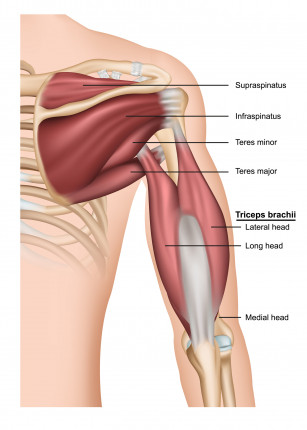
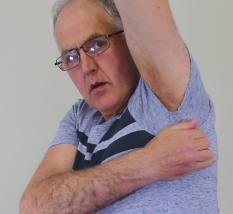
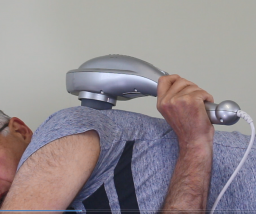
Upper trapezius muscle
Self massage
You can reach this muscle easily an use the pads of your fingers to do the massage
Thai home therapy
As this diagram shows it is easy to use your fingers to apply moderate pressure
Vibration massage
The important thing here is to hold the massager with the opposite side hand. This makes sure the muscle you are massaging is relaxed.
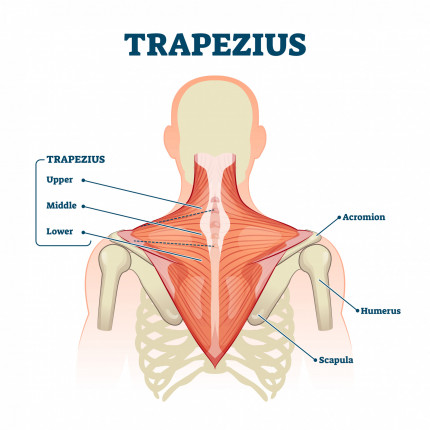
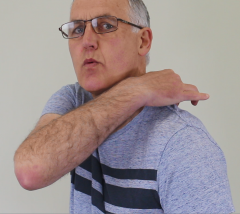
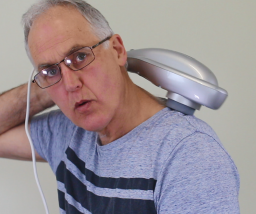
Deltoid muscles
As the diagram shows these muscles wrap around the outside of your shoulder. It is divided into three parts: Anterior (front), middle and posterior (back).
Self massage
This muscle can be massaged by reaching across with the opposite hand and using the flats of your fingers.
Thai self massage
It is easy to apply moderate pressure to trigger points using the same technique.
Vibration massage
This can be done sitting, or lying down as in the picture below.
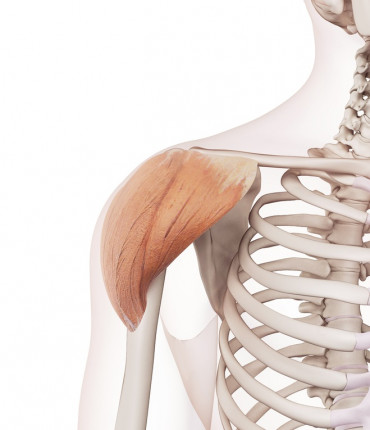
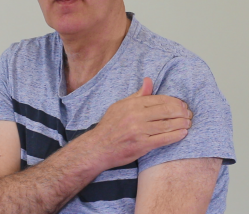
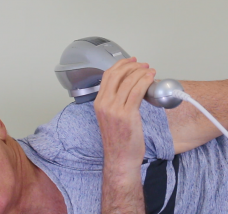
Supraspinatus muscle
The supraspinatus muscle sits in a groove at the top of your shoulder blade. It sits directly below part of the upper trapezius muscle.
Self massage
This can be done using the tips of your fingers similar to the way pictured in the trigger point therapy. However, as the muscle is deep you need strong fingers.
Thai self massage
Use the tips of your fingers as shown. The muscle is deep.
Vibration massage
It is far easier to let the vibrations penetrate as shown.
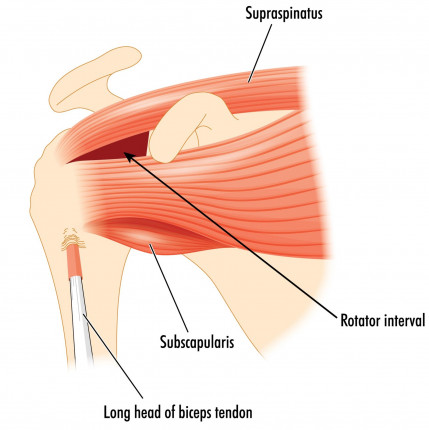
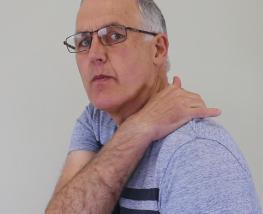
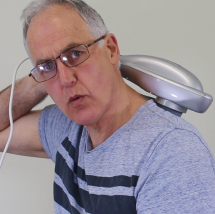
Middle and lower trapezius
Self massage
These muscles are at the back where you cannot easily reach.
Thai self massage
These muscles can be easily reached using a tool like previously discussed.
Vibration massage
It is easy to apply vibration to these muscle using a vibration massager. Note that because of their lack of a proper handle you won't be able to reach these properly with a massage gun.
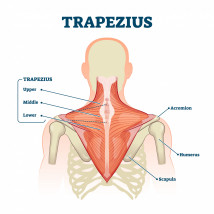
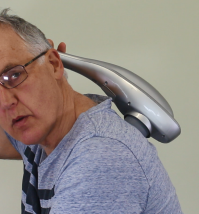
Subscapularis
This muscle sits underneath your shoulder blade between your shoulder blade and rib cage. You cannot easily get at it, but you can get at part if you pull your shoulder blade outwards.
Self massage
This muscle is too hard to get at for self massage.
Thai self massage
You can get at the outside of this muscle with your thumb as shown.
Vibration massage
This is by far the easiest and most effective. Note that to get access to this difficult part I've used the smaller head. Also, because it is the vibrations that penetrate it can effect the muscle far further behind the shoulder blade.
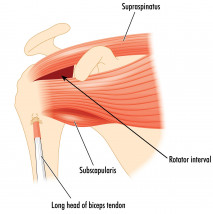
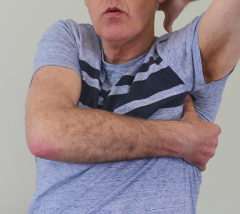
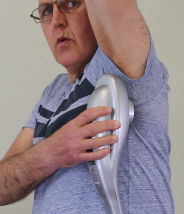
Pectoralis major muscle
Self massage
This muscle is at the front of your chest so is easy to reach and self massage.
Thai self massage
As shown in the picture this muscle is very easy to access for self trigger point therapy.
Vibration massage
Again, a very easy muscle to access
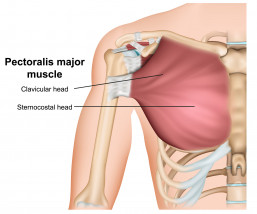
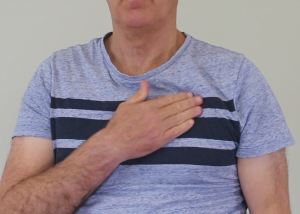
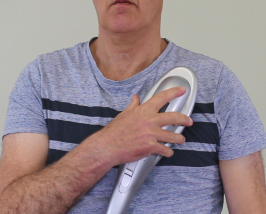
Pectoralis minor muscle
This muscle is underneath part of the pectoralis major muscle. It is very important because it sits directly over the major nerves and blood vessels that go down your arm. If it is tight it can cause "pectoralis minor syndrome" which is where the nerves to your arm are irritated and blood circulation restricted.
Self massage
This muscle is at the front of your chest so is easy to reach and self massage.
Thai self massage
As shown in the picture this muscle is very easy to access for self trigger point therapy.
Vibration massage
Again, a very easy muscle to access.
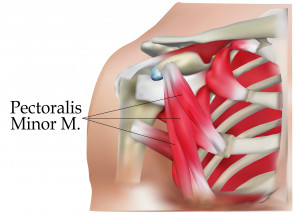
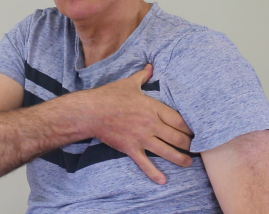
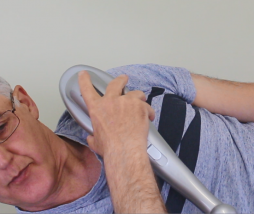
Biceps and triceps muscles
Self massage
These muscles are at the front and back of your upper arm so are easy to reach and self massage.
Thai self massage
As shown in the pictures these muscles are very easy to access for self trigger point therapy.
Vibration massage
Again, a very easy muscles to access
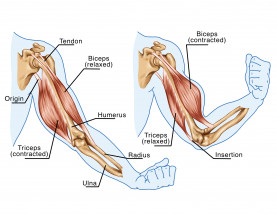
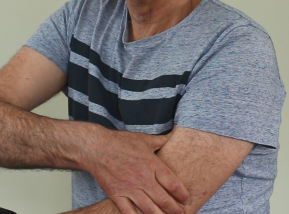
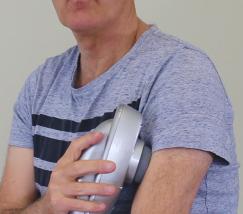
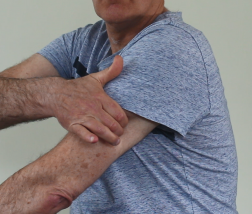
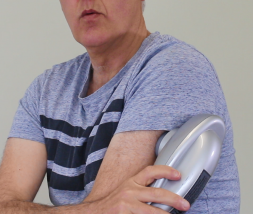
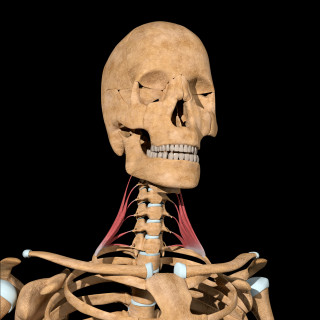
Scalene muscles
The scalene muscles run along side some major nerves and blood vessels, plus there are sharp pointed parts of your spine directly beneath. For safety reasons don't touch this muscle unless given specific instructions by your professional.
Other things you need to consider
While musclular problems and trigger points are an important and too often overlooked cause of shoulder pain there are other issues that need to be considered. Also, a lot of medical treatments including "corrective exercises" are not suppoorted by evidence and too often do more harm than good. For further information please see the following articles.
Why shoulder pain keeps coming back and what you can do about it
Do exercises help shoulder pain
Other self massage and trigger point therapy articles
If you found this useful please check out our other self massage and trigger point therapy articles.
- Self massage and trigger point therapy for headaches and migraines
- Massage And Trigger Point Therapy For Low Back Pain, With Self Help Options
- Massage And Trigger Point Therapy For Calf Pain, With Self Help Options
- Self Massage And Trigger Point Therapy For Tennis Elbow
- Trigger Point Therapy For Fibromyalgia: Inc. Self Help Advice
- Self Massage For High Blood Pressure
- Self Massage For Anxiety
Professionals
DrGraeme massagers were originally built by Dr Graeme for use in his clinic, and to prescribe to his patients for additional self use at home. Now these are used by colleagues and other professionals for similar purposes. If you are a professional and wish to know more about this therapy, or possibly get a sample massager to trial please check out our practitioner page.
References
- Bron C, De Gast A, Dommerholt J, Stegenga B, Wensing M, Oostendorp RAB. Treatment of myofascial trigger points in patients with chronic shoulder pain: A randomized, controlled trial. BMC Med. 2011;9.
- Sergienko S, Kalichman L. Myofascial origin of shoulder pain: A literature review. J Bodyw Mov Ther . 2015;19(1):91–101.
- Senbursa G, Baltacı G, Atay A. Comparison of conservative treatment with and without manual physical therapy for patients with shoulder impingement syndrome: A prospective, randomized clinical trial. Knee Surgery, Sport Traumatol Arthrosc. 2007;15(7):915–21.
- Yemul SR. COMPARISON OF SUPERVISED EXERCISE WITH AND WITHOUT MANUAL PHYSICAL THERAPY FOR PATIENTS WITH SHOULDER IMPINGEMENT SYNDROME. J Cur Res Rev . 2013;05(05):5.
- Van Den Dolder PA, Roberts DL. A trial into the effectiveness of soft tissue massage in the treatment of shoulder pain. Aust J Physiother . 2003;49(3):183–8.
- Bang MD, Deyle GD. Comparison of supervised exercise with and without manual physical therapy for patients with shoulder impingement syndrome. J Orthop Sports Phys Ther. 2000;
- Van Den Dolder PA, Ferreira PH, Refshauge KM. Effectiveness of soft tissue massage and exercise for the treatment of non-specific shoulder pain: A systematic review with meta-analysis. Br J Sports Med. 2014;48(16):1216–26.
- Hains G, Descarreaux M, Hains F. Chronic Shoulder Pain of Myofascial Origin: A Randomized Clinical Trial Using Ischemic Compression Therapy. J Manipulative Physiol Ther 2010;33(5):362–9.
- Bron C. High prevalence of shoulder girdle muscles with myofascial trigger points in patients with shoulder pain. BMC Musculoskelet Disord. 2011;12.
- Holmes RE, Barfield WR, Woolf SK. Clinical evaluation of nonarthritic shoulder pain: Diagnosis and treatment. Phys Sportsmed. 2015;43(3):262–8.
- Wamontree P, Kanchanakhan N, Eungpinichpong W, Jeensawek A. Effects of traditional Thai self-massage using a Wilai massage stickTM versus ibuprofen in patients with upper back pain associated with myofascial trigger points: a randomized controlled trial. J Phys Ther Sci. 2015;27(11):3493–7.
We are continually adding more information on research and uses. Subscribe below to have us email them to you "hot off the press".

About Dr Graeme
Several years ago Dr Graeme, a Chiropractor practicing in Victoria, Australia was looking for a serious hand held massager his patients could use at home to get the extra quality massage they needed. The ones he found in the shops and on-line for home use looked nice but were not serious, and... read more


